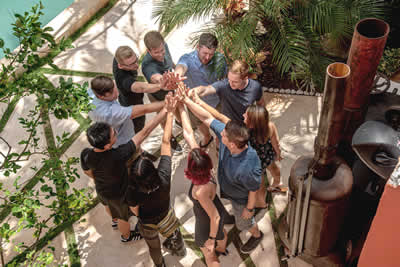If you want to manage a successful team, you likely need to spend a lot of time building it! Even when people are working well, there will be aspects of how they operate that need improvement. And although you rarely need to start from scratch – unless you’re working in a startup, of course – it’s useful to take your thoughts back to basics when you think about making changes.
And whether you manage a small startup or a large corporate department, encouraging collaboration, trust, and communication among members is central to your success. But of course, being effective goes beyond the occasional event or meeting. It requires carefully thought-through strategies that go together to create a sense of unity and help people work together towards common goals. Which are, of course, your goals.

This article looks at the most effective strategies, how to put them into action, and the impact they can have on your performance.
Why Team Building Matters
In any situation, success rarely happens in isolation. Teams drive
growth, innovation, and results. But even skilled professionals will struggle if they don’t work with other people. And when you focus on team building, you’ll improve morale and, of course, productivity. This is, after all, what you’re after…
Team building has several key benefits:
- Improved communication: Open dialogue helps employees to get to know one another better, leading to easier relationships
- Boosted morale: A united team feels more supported, motivated, and connected, which lifts everyone’s “mood”
- Increased trust: People who trust each other are more likely to share ideas and work together more effectively
A well-implemented strategy creates a positive environment that drives productivity, creativity, and cooperation.
Team Building Activities That Work
Obviously, not all team-building activities are equally effective. Some can feel forced or irrelevant, and in this case can actually be counterproductive. The best will reflect employees’ interests and lead to meaningful engagement.
Here are some that lead to better relationships and keep people fully engaged:

- Outdoor activities: Sports like hiking or casual team games where trust and teamwork feature in a relaxed environment. To give an event more impact, you can buy sports kit to create a competitive yet fun atmosphere. Here’s an example of what to do with custom softball jerseys.
- Escape rooms: These challenge people to solve puzzles in groups, under pressure. If they’re set up properly they can translate well into real-world problem-solving.
- Workshops and learning sessions: Skill-building workshops encourage growth and team cooperation. They can cover all sorts of topics from project management to creative brainstorming.
- Volunteering: If you really want to push the envelope you can arrange for employees to take part in community service events together. This strengthens bonds and reinforces a sense of shared purpose.
As you can see, there are different ways you can promote teamwork, while allowing people to build relationships outside the traditional office setting. And this ultimately improves they way they operate when they’re back at work.

If you'd like to learn more about customer service, why not take a look at how we can help?
Boost your customer service skills with our online courses.
RRP from $65 – limited time offer just
$23.99
Creating a Culture of Team Building
But don’t forget that you also need to go beyond one-off events. To build a truly effective environment, you need to create an ongoing atmosphere where
communication and cooperation are part of everyday life.
So here are ways to build the right culture:
- Encourage open communication: Hold regular meetings where people can voice their concerns and also share ideas. This last option is actually a bit of free consultancy, raising possibilities you may well not have thought about…
- Promote cross-functional input: This means getting people from different departments to work together to broaden views and break down artificial walls.
- Encourage mentorship: Assign junior staff members to work with senior staff on a kind of mentorship basis to encourage learning. With your positive support, senior staff often enjoy this more than they expect – and even learn stuff themselves!
- Celebrate everyone’s achievements: Acknowledge milestones and successes regularly to build a positive, success-based atmosphere that promotes camaraderie and appreciation.
By embedding practices like these into your daily operations, you’ll create a culture of collaboration and teamwork.
The Power of Storytelling
It's often a good idea to use
storytelling as a highly effective way to strengthen bonds between people. When they share personal or professional experiences with others, they connect on a deeper level, and this builds empathy and awareness.

One really effective idea is to create
photo books which document significant work events. We’re talking here about things like project milestones, corporate retreats, or important company moments. But anything goes really.
These reminders of people’s shared experiences help to reinforce bonds and provide a sense of unity. Newer employees can also get a sense of the history – and continuity – of the team. Which helps to smooth their induction. Storytelling can take many forms, formal or informal, and it’s a positive reminder to people that they are working together toward a common goal.
Achieving Long-Term Success
Always remember that if you’re going to be effective, you need to be on the case all the time. Developing a culture where employees feel connected, valued, and motivated to work together takes a great deal of effort on your part! And once you’re there, you’ve done the hard yards, so it becomes easier.
But don’t slacken off! By keeping up a consistent and focused effort, you can create a team where everyone communicates openly, trusts each other, and works together to achieve its full potential.
And you’ll have done your job…




























